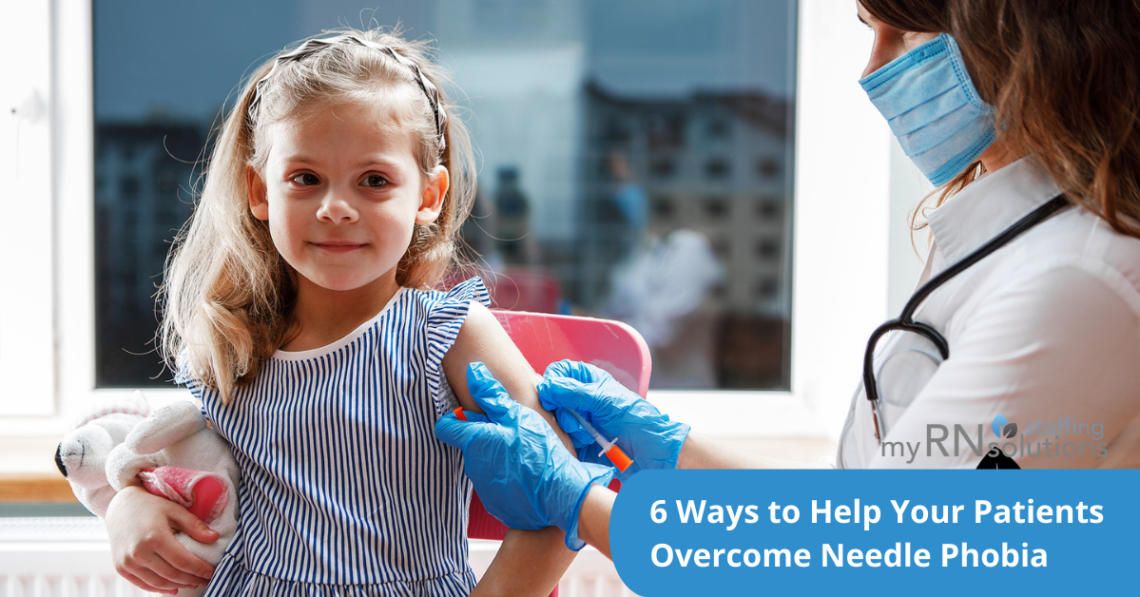
Working in pediatrics has given me ample time to work on addressing needle phobia. Sometimes I don’t even have a needle visible, and the simple act of reaching out to feel for a vein causes an immediate screaming tantrum – complete with kicking and flailing and all out hysteria.
Needle phobia is estimated to be in 20-50% of children and adolescents (McLenon and Rogers 2019). I’ve had two-year-olds wiggling and trying to run away from their parent’s laps because they realize a blood draw is coming. I’ve had to wait 30 minutes for an eight-year-old to let me draw her blood (only agreeing after Mom promised her brownies and a sleepover with friends as a reward). In teenagers, I’ve had more kids than I can count either decide to vomit, almost faint, or actually faint. No matter the age, there is always someone who has an adverse reaction to needles.
Needle phobia is real, and one of my tasks is to figure out how to make it easier for children.
Ways to Help Your Patients Overcome Needle Phobia
Distraction
The list is endless here! I’ve used light-up wands, virtual reality glasses, iPads, Smartphones, and music. If you can shift the focus to something more interesting, the anticipation of a poke is washed away from the child’s mind. We also frequently use a “Buzzy Bee,” which is a vibrating plastic bumble bee that you place on the child’s arm between the needle insertion site and the child’s brain. The hope is to distract any physical and mental sensors away from the poke and towards the vibration buzzing.
Pain Reducers
We have EMLA topical numbing cream that we send in the mail to pediatric patients, to help make the blood draw less painful. They are instructed to apply it at least 15 minutes before the appointment to numb the skin at the needle insertion site. We also have cold numbing spray (affectionately referred to as “Elsa spray” for the girls who like “Frozen”) that numbs the blood draw site. Both options help reduce the pain of needle pokes, as well as help reduce the fear of the pain.
Reasonable Choices
Give the child control! There are choices you can give the child to give them more control in a situation that may seem overwhelming. I usually have three different colors of Coban wrap for them to choose from, and I let them choose what arm to draw the blood on. Do they need someone to hold their hand or sit on a parent’s lap? Small things like these can give comfort! Obviously, it’s not always appropriate to give them the option NOT to do the blood draw, but again, you have to read the situation and determine what is best.
Preparation (as best you can)
There will be situations when you just have to do the blood draw. If the kid is wiggling and moving, have another nurse or medical team member hold the arm of the child (sadly, the parent is not always the most helpful when trying to firmly hold a child’s arm). A jerking arm can cause way more damage when a needle is out. Also, I always ask a pediatric patient if they have ever had a blood draw before, and if so, I ask how it went in the past. I want to know if the child has a history of nausea or fainting, so I can also prepare the child and myself as best I can (laying them down in a bed, using distraction, etc).
Explain
Just like with an adult patient, a child likes to know what’s going on. I always talk through what I’m about to do, why I’m doing it, and how I’m going to do it. A lot of the fear related to needle phobia is from the unknown, and explaining the process with kids can help diffuse fear.
Comforting Items
If a needle poke is scary, why not encourage kids to bring their blanket or stuffed animal that they love? It’s all about making them feel courageous and brave. Obviously, this doesn’t really apply for teenagers, but the younger kids that I work with regularly introduce me to their favorite “stuffies,” and sometimes I even get to draw their stuffed animal’s blood, too!
Rewards
I know this one can be controversial. We have small incentives at our clinic like stuffed animals, key chains, and stickers. I leave other rewards up to the parents, like ice cream or anything else tasty/desirable. If the kid is old enough to reason with the parent, I’ve seen many an anxious child decide that a poke in the arm is worth it for a strawberry ice cream cone with sprinkles. Positive reinforcement can be powerful, but our ability to do that as nurses is limited.
Acceptance
Sometimes you just aren’t going to get a child’s vein. My clinic determined that two pokes are allowed per RN, and then it’s up to the parent and child if another poke should be attempted by a different RN. Rather than continue to try to poke a child whose veins are not easily found, it might be better to try again a different time rather than create a traumatizing experience.
Even though the child is technically the patient in pediatric situations, it is good practice to involve the parent in the child’s care. Anxiety in parents can trickle to the children, so explaining what you are doing to the parent is just as important as explaining it to the child. Set realistic expectations, so that the parent knows that it’s not always a guarantee that the nurse will successfully get into a vein on the first try (however, we try as hard as we can!). Honesty is the best policy in pediatric needle phobia, always.
There are situations where the needle phobia is so extreme that I might refer a patient to a more rigorous process with a trained professional to work on coping skills and desensitization. When a child needs to have blood draws not just for research but for disease management, it becomes crucial to find ways to make those arm pokes just a bit better.
What about you? I would love to hear your ideas for helping kids to overcome their phobia of needles!
Resources:
McLenon, J and Rogers, M. Fear of needles: A systematic review and meta-analysis. Journal of Advanced Nursing 2019.









Write a comment: